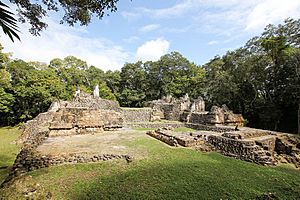Uaxactun facts for kids
| Lua error in Module:Wikidata at line 70: attempt to index field 'wikibase' (a nil value).
Temple of the Masks
|
|
| Lua error in Module:Location_map at line 420: attempt to index field 'wikibase' (a nil value). | |
| Region | Petén Department, Guatemala |
|---|---|
Uaxactun (say "wah-shak-TOON") is an ancient city. It was a very important and sacred place for the Maya civilization. You can find it in the Petén Department of Guatemala. It's about 12 miles (19 km) north of another big Maya city called Tikal. Sometimes, people spell its name as Waxaktun.
Contents
Discovering Uaxactun's Past
Scientists have learned a lot about the ancient Maya. They can now read many Maya hieroglyphic writings. These writings show that Uaxactun's old name was Siaan K'aan. This means "Born in Heaven."
The name Uaxactun was given by an archaeologist named Sylvanus Morley. He found the site again in May 1916. He combined two Maya words: Waxac (meaning "eight") and Tun (meaning "stone"). So, Uaxactun means "Eight Stones."
Morley chose this name for two reasons. First, it was the first place where a Maya calendar date from the 8th Baktún was found. This made it the oldest known Maya date at the time. Second, the name "Uaxactun" sounds a bit like "Washington." This was a fun way to honor Washington, D.C., where the Carnegie Institution for Science was located. This institution helped fund Morley's trips.
Morley first looked at the writings at Uaxactun. Then, no one visited the site again until 1924. That's when Frans Blom came and made a detailed map of the buildings.
From 1926 to 1937, the Carnegie Institution did big digs there. Oliver Ricketson led these excavations. Their work taught us a lot about the early Maya periods. They found older, well-preserved temples hidden under newer, ruined ones.
For many years, getting to Uaxactun was hard. The Carnegie team used mules to travel for four days to El Cayo, in what was then British Honduras (now Belize). Later, an airstrip was built, making travel easier. A small village grew there, as it became a place for collecting chicle sap from the jungle.
In 1940, A. L. Smith and Ed Shook did more digging. In the late 1970s, a rough road connected Uaxactun to Tikal. Then, it connected to Flores, Guatemala. Air flights stopped after that. The road got much better in 1984.
Shook came back in 1974 to help fix and restore some of the old buildings. In 1982, Uaxactun became part of Guatemala's Tikal National Park. This protected the ruins. In 1990, the Maya Biosphere Reserve (MBR) was created. Uaxactun is now part of this large protected area.
Since 2009, a team from the Slovak Archaeological and Historical Institute (SAHI) has been working there. Professor Milan Kováč leads their project.
Uaxactun and the Powerful Siyaj K'ak'
The historian Linda Schele wrote about a war between Tikal and Uaxactun. Uaxactun was defeated by an army led by a powerful leader named Fire is Born, also known as Siyaj K'ak'. This happened in 378 AD.
After this war, Tikal and Uaxactun together controlled the Petén Basin region for about 180 years. Siyaj K'ak' might have come from Teotihuacán, a very powerful city far away. He may have been a general for Teotihuacán's ruler, Spearthrower Owl. Siyaj K'ak' might have conquered Tikal earlier in the same year.
This event was a huge turning point for the Classic Maya. Some experts believe new kings were put in charge in many Maya cities, including Uaxactun and Tikal. New traditions and art were also introduced. This created a new order in the Maya Lowlands. Other experts think Teotihuacán had less direct control over the Maya.
Uaxactun After the Conquest
Even after being conquered by Siyaj K'ak' in 378 AD, Uaxactun remained important. Its leaders could still carve monuments, build temples, and have rich burials. This lasted through most of the Early Classic period.
Around 600 AD, there was a quiet time for Uaxactun. There wasn't much building or pottery making. This happened when the power of Teotihuacán and Tikal also seemed to slow down. No new monuments were built between 554 AD and 711 AD.
By the middle of the Late Classic period, Uaxactun grew again. More people lived there, and new buildings were constructed. Old buildings were fixed up, and new living areas appeared. However, the population started to decrease towards the end of the Late Classic period. The last monument with a date in Uaxactun is from 889 AD. By the end of the Terminal Classic period, Uaxactun and Tikal were mostly abandoned.
See also
 In Spanish: Uaxactún para niños
In Spanish: Uaxactún para niños



